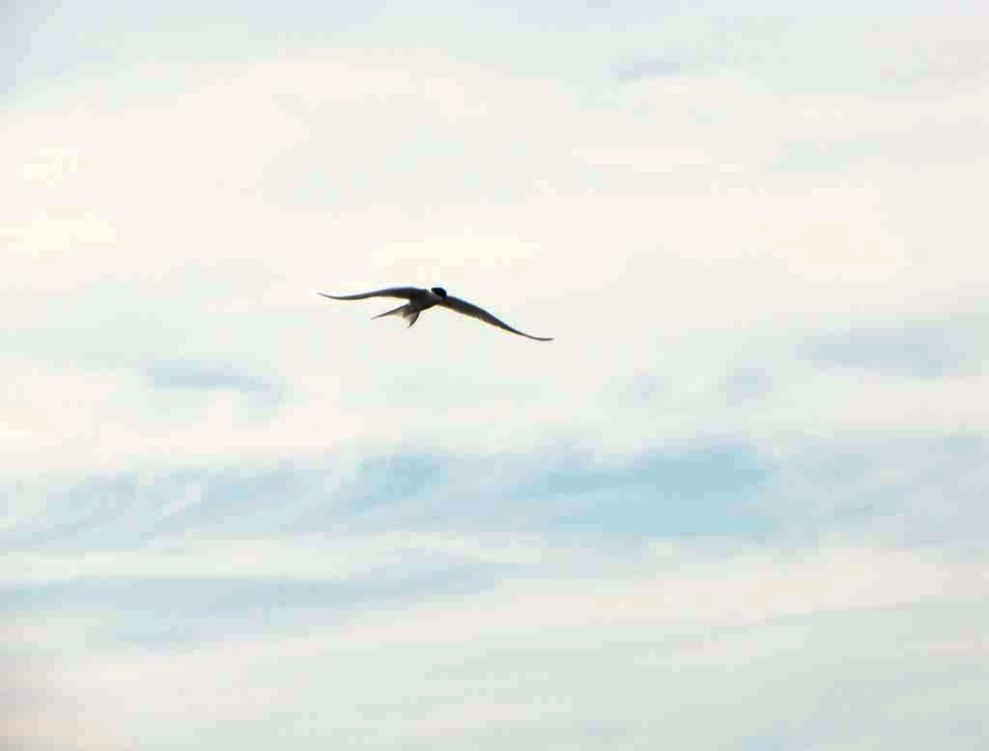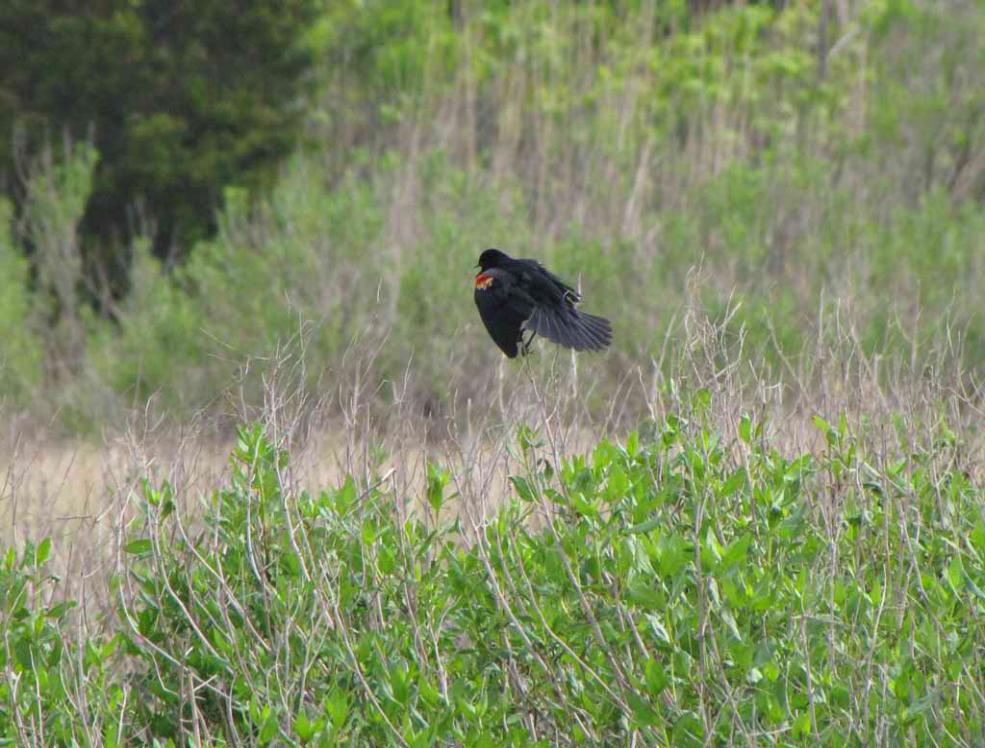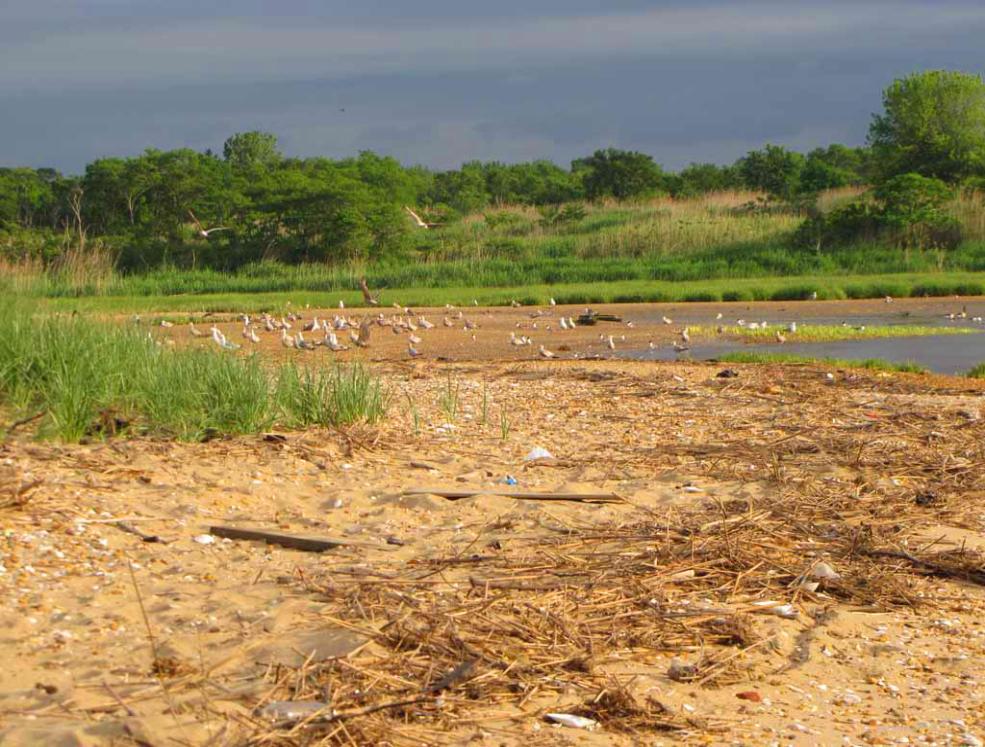| Click here for Home Page to see List of All My Trips and Three Methods to search my Travelogue website for web pages of interest to you |
| Spring Bird Watching at Sandy Hook in New Jersey |
****************************************
In case if you see overlapped lines of text or some lines of text become obscured behind a picture on this web
page, please change the page magnification (zoom) factor to eliminate such problems by pressing these two
keys "Ctrl +" simultaneously or these two keys "Ctrl -" simultaneously. Depending on your PC setting, it may be
necessary to reduce the magnification factor several steps down in order to eliminate the overlap and
obstructed text lines.
Please press the F11 key (Fn key and F11 key on laptop PC) on your keyboard to get full-screen view of
photos and web page. Pressing F11 key again will return to your normal screen with various tool bars.
****************************************
In case if you see overlapped lines of text or some lines of text become obscured behind a picture on this web
page, please change the page magnification (zoom) factor to eliminate such problems by pressing these two
keys "Ctrl +" simultaneously or these two keys "Ctrl -" simultaneously. Depending on your PC setting, it may be
necessary to reduce the magnification factor several steps down in order to eliminate the overlap and
obstructed text lines.
Please press the F11 key (Fn key and F11 key on laptop PC) on your keyboard to get full-screen view of
photos and web page. Pressing F11 key again will return to your normal screen with various tool bars.
****************************************
On Saturday, May 22, 2010, we came to the Plum Island in Sandy Hook Gateway National Recreation Area in
New Jersey for bird watching and for watching horseshoe crabs. There were many birds on the beach of the
Plum Island, including oyster catcher, Brant, gulls, terns, etc.
New Jersey for bird watching and for watching horseshoe crabs. There were many birds on the beach of the
Plum Island, including oyster catcher, Brant, gulls, terns, etc.
There were also one or two ospreys (fish hawks) on the nest which is not too far from the Plum Island
Another view of many busy and noisy birds on the beach, on the water and in the air at the Plum Island in
Sandy Hook.
Sandy Hook.
On our way home from Sandy Hook, we made a small detour from Highway 36 to go to Conaskonk Point near
the mouth of Chingarora Creek in Union Beach on Raritan Bay in New Jersey to see more birds and
horseshoe crabs.
the mouth of Chingarora Creek in Union Beach on Raritan Bay in New Jersey to see more birds and
horseshoe crabs.
A pair of spawning horseshoe crabs on the beach at Conaskonk Point in Union Beach. The female horseshoe
crab dug into the sand to lay eggs under the sand. The male horseshoe crab latched behind the female
horseshoe crab.
crab dug into the sand to lay eggs under the sand. The male horseshoe crab latched behind the female
horseshoe crab.
There were some egrets and red winged black birds at Conaskonk Point.
In addition to the beach, there is a large area of salt marsh at Conaskonk Point. We heard many interesting
kinds of bird sounds even though we could not see those birds hiding in the salt marsh.
Delaware Bay has the highest concentration of spawning horseshoe crabs and is the best place to watch
large number of spawning horseshoe crabs as shown on my Travelogue web page at:
http://www.shltrip.com/Horseshoe_Crab.html
The number of spawning horseshoe crabs at other beaches outside of Delaware Bay is usually much smaller
than those on beaches (Such as Pickering Beach and Reeds Beach) in Delaware Bay.
kinds of bird sounds even though we could not see those birds hiding in the salt marsh.
Delaware Bay has the highest concentration of spawning horseshoe crabs and is the best place to watch
large number of spawning horseshoe crabs as shown on my Travelogue web page at:
http://www.shltrip.com/Horseshoe_Crab.html
The number of spawning horseshoe crabs at other beaches outside of Delaware Bay is usually much smaller
than those on beaches (Such as Pickering Beach and Reeds Beach) in Delaware Bay.
Direction to Plum Island in Sandy Hook in Middletown in Monmouth County along east coast of
New Jersey:
1. Take Highway 36 south in Middletown, New Jersey to drive into Sandy Hook Gateway National Recreation
Area,
2. After you pass through the Entrance Fee Plaza, park your car in the First large and long parking lot of South
Beach Area B with a building of toilet facility on the right side of the road. (Both the First Parking Lot and the
Plum Island are within 0.25 mile of the Entrance Fee Plaza of Sandy Hook. After you pass through the
Entrance Fee Plaza, drive "slowly" so that you do not miss the First Parking Lot on the right side.)
3. The Plum Island is on the left side of the road (Hartshorne Drive) as shown on the map above. From Parking
Lot of South Beach Area B, walk across the road into the Plum Island. Continue walking west around the
lagoon for about half mile to the beach facing Sandy Hook Bay which narrows down to become Navesink River
(i.e., not the Atlantic Ocean side of the beach and not the marshes surrounding the lagoon.) to see the birds
actions.
Map: Click here to see Google Map showing location of Sandy Hook, New Jersey
Direction to Conaskonk Point in Union Beach in New Jersey:
• Take the Garden State Parkway to Exit 117 and get on Rt. 36 East.
• Turn Left (north) into Poole Ave
• Turn Left (North) into Edmunds Ave
• Go to the end of Edmund Ave and turn left into Chingarora Street.
• Park your car along the Chingarora Street, and walk out the unpaved dirt road for about half mile to the
beach. Most activities of birds and horseshoe crabs are to the left side of the beach near the mouth of
Chingarora Creek.
Note: There is a metal gate and metal fence at the beginning of this dirt road. This dirt road is almost like an
unpaved extension of the paved Edmunds Ave to go north through the marsh to the beach. While walking on
this dirt road, we met some people carrying fishing poles to go fishing on the beach.
Map: Click here to see Google Map showing location to park your car, then walk half mile to beach
If you click on the Satellite View on the interactive Google Map, you will see the unpaved dirt road from the end
of Edmunds Ave to reach the beach.
New Jersey:
1. Take Highway 36 south in Middletown, New Jersey to drive into Sandy Hook Gateway National Recreation
Area,
2. After you pass through the Entrance Fee Plaza, park your car in the First large and long parking lot of South
Beach Area B with a building of toilet facility on the right side of the road. (Both the First Parking Lot and the
Plum Island are within 0.25 mile of the Entrance Fee Plaza of Sandy Hook. After you pass through the
Entrance Fee Plaza, drive "slowly" so that you do not miss the First Parking Lot on the right side.)
3. The Plum Island is on the left side of the road (Hartshorne Drive) as shown on the map above. From Parking
Lot of South Beach Area B, walk across the road into the Plum Island. Continue walking west around the
lagoon for about half mile to the beach facing Sandy Hook Bay which narrows down to become Navesink River
(i.e., not the Atlantic Ocean side of the beach and not the marshes surrounding the lagoon.) to see the birds
actions.
Map: Click here to see Google Map showing location of Sandy Hook, New Jersey
Direction to Conaskonk Point in Union Beach in New Jersey:
• Take the Garden State Parkway to Exit 117 and get on Rt. 36 East.
• Turn Left (north) into Poole Ave
• Turn Left (North) into Edmunds Ave
• Go to the end of Edmund Ave and turn left into Chingarora Street.
• Park your car along the Chingarora Street, and walk out the unpaved dirt road for about half mile to the
beach. Most activities of birds and horseshoe crabs are to the left side of the beach near the mouth of
Chingarora Creek.
Note: There is a metal gate and metal fence at the beginning of this dirt road. This dirt road is almost like an
unpaved extension of the paved Edmunds Ave to go north through the marsh to the beach. While walking on
this dirt road, we met some people carrying fishing poles to go fishing on the beach.
Map: Click here to see Google Map showing location to park your car, then walk half mile to beach
If you click on the Satellite View on the interactive Google Map, you will see the unpaved dirt road from the end
of Edmunds Ave to reach the beach.
Closer views of some of the terns in flight looking for fish to catch
The most exciting part of this trip is seeing such a high concentration of large number of terns and gulls busily
flying around, hovering in mid-air looking down for fish to catch, and diving straight down to the water surface
to catch the fish. Therefore, I took two movie clips of such exciting and noisy activities of these fishing birds at
the Plum Island. The two movie clips are on the following YouTube websites. Please click on the icon at the
lower right corner of the YouTube screen to enjoy the full screen show of such busy activities of these fishing
birds:
http://www.youtube.com/watch?v=mx4oYGf-jyk
http://www.youtube.com/watch?v=RKT49bUN1Xs
flying around, hovering in mid-air looking down for fish to catch, and diving straight down to the water surface
to catch the fish. Therefore, I took two movie clips of such exciting and noisy activities of these fishing birds at
the Plum Island. The two movie clips are on the following YouTube websites. Please click on the icon at the
lower right corner of the YouTube screen to enjoy the full screen show of such busy activities of these fishing
birds:
http://www.youtube.com/watch?v=mx4oYGf-jyk
http://www.youtube.com/watch?v=RKT49bUN1Xs
We also saw this osprey (fish hawk) hovering above the lagoon between the Plum Island and Hartshorne Drive
in Sandy Hook, looking down for fish to catch. Osprey is also very skillful to dive from mid-air down into the
water below to catch fish if it finds a fish while hovering in the mid-air and looking down. Please see the diving
actions of osprey in my previous trips at my Travelogue web pages at:
www.youtube.com/watch?v=mx4oYGf-jyk
http://www.shltrip.com/More_on_Spring_in_Holmdel_Park.html
in Sandy Hook, looking down for fish to catch. Osprey is also very skillful to dive from mid-air down into the
water below to catch fish if it finds a fish while hovering in the mid-air and looking down. Please see the diving
actions of osprey in my previous trips at my Travelogue web pages at:
www.youtube.com/watch?v=mx4oYGf-jyk
http://www.shltrip.com/More_on_Spring_in_Holmdel_Park.html
We saw this horseshoe crab upside down on the beach on Plum Island. There were also several pairs of
horseshoe crabs swimming or crawling about one foot below the water surface on the sand. We came on
May 22 which is 5 days too early to see large number of spawning horseshoe crabs on the beach on the Plum
Island because the date of full moon is May 27, 2010. Usually the number of spawning horseshoe crabs on
the beach peaks on the night of full moon at high tide. Please see my Travelogue web page at:
http://www.shltrip.com/Horseshoe_Crab.html
to see the large number of spawning horseshoe crabs on the beach on Delaware Bay. Therefore, the number
of spawning horseshoe crabs on the beach at Plum Island is expected to increase substantially in the next few
days to reach its peak on May 27.
horseshoe crabs swimming or crawling about one foot below the water surface on the sand. We came on
May 22 which is 5 days too early to see large number of spawning horseshoe crabs on the beach on the Plum
Island because the date of full moon is May 27, 2010. Usually the number of spawning horseshoe crabs on
the beach peaks on the night of full moon at high tide. Please see my Travelogue web page at:
http://www.shltrip.com/Horseshoe_Crab.html
to see the large number of spawning horseshoe crabs on the beach on Delaware Bay. Therefore, the number
of spawning horseshoe crabs on the beach at Plum Island is expected to increase substantially in the next few
days to reach its peak on May 27.
There were also many birds near the mouth of Chingarora Creek at Conaskonk Point.
We also saw a boat-tailed grackle near the Plum Island
There were also many terns and gulls flying 10 to 20 feet above the water looking for fish and diving down to
the water surface to catch fish.
the water surface to catch fish.
In addition to many terns and gulls, we also saw some red-winged black birds on the Plum Island.


An egret just landed at the water edge of the lagoon on the east side of the Plum Island



One of several shorebirds at the Conaskonk Point, probably eating the eggs of horseshoe crabs.
A group of shorebirds in flight at Conaskonk Point, probably flying from one spot to another spot on the beach
to eat horseshoe crab eggs.
to eat horseshoe crab eggs.

A view of Raritan Bay from the beach of Conaskonk Point in Union Beach.





















A map of the southern part of Sandy Hook near the entrance. It shows the location of Plum Island in Sandy
Hook.
Hook.

| 讀萬卷書 行萬里路 |
